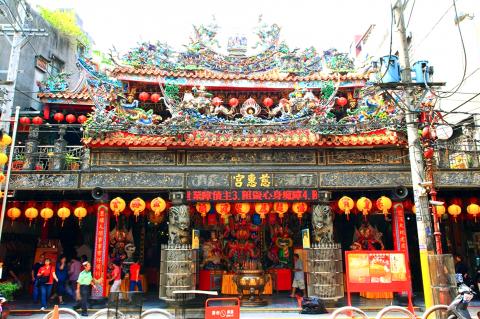The New Taipei City (新北市) Government last week launched a bimonthly journal focusing on interfaith worship, religious festivals, ritual ceremonies and sacred shrines around the city.
The Chinese-language journal, which debuted on Jan. 2, is called Bo Pi New Taipei City (保庇新北市).
Bo pi is the Taiwanese way of referring to divine protection.

Photo: Tseng Te-feng, Taipei Times
Readers can turn to the journal to learn about the diverse religious cultures in the city, city officials said.
Those looking for divine blessings and guidance on gaining wealth, having a son or daughter, finding a lover or job prospects, can find advice in the journal, they said.
According to the city’s Civil Affairs Bureau, New Taipei City was the original starting place for migrant settlement and opening up new lands in northern Taiwan hundreds of years ago.
With such an historic and cultural background, it has an abundance of Buddhist-Taoist temples and Christian churches.
There are 952 registered temples and 120 churches, including 160 Buddhist-Taoist temples that are more than 100 years old, the bureau said.
There are also more than 3,000 Taoist shrines, called shentan (神壇), as well as “deity worship associations” (神明會) under the city’s supervision, the bureau said.
Two of the nation’s five major Buddhist monasteries are located in New Taipei City: Dharma Drum Mountain in Jinshan (金山) and the Ling-Jiou Mountain Monastery in Gongliao (貢寮).
Surveys by the bureau suggest that on average, there are two temples, shentan or churches per square kilometer around the city — with their highest density in Banciao (板橋), Sanchong (三重) and Yonghe (永和) districts.
Hsichih (汐止) and Sansia (三峽) districts have the highest number of registered temples, while Wulai District (烏來) has the fewest registered temples.
The top three deities worshiped in the city’s Buddhist-Taoist temples are the Earth God (土地公), Kuanyin (觀世音) and Matsu (媽祖), government surveys showed.
“From the establishment of these temples and churches, we can follow the historic and demographic development trends of our city. They are also the focus of important local festivals that preserve and pass down the cultural traditions and ritual ceremonies with their unique regional characteristics,” said Chiang Chun-ting (江俊霆), head of the Civil Affairs Bureau.
The bureau has also created a calendar listing temple festivals and religious celebrations for this year, which will be made available online as well as in Bo Pi New Taipei City, he said.
“This way we can introduce the public to the many unique temple festivals and religious celebrations around New Taipei City,” Chiang said.
Bo Pi New Taipei City will be published every other month, on the 20th, and will be available at libraries, local district offices and district household registration offices. It is also produced in ebook format, which can be downloaded at www.ca.ntpc.gov.tw/24;data_pagenode/details/.

US climber Alex Honnold is to attempt to scale Taipei 101 without a rope and harness in a live Netflix special on Jan. 24, the streaming platform announced on Wednesday. Accounting for the time difference, the two-hour broadcast of Honnold’s climb, called Skyscraper Live, is to air on Jan. 23 in the US, Netflix said in a statement. Honnold, 40, was the first person ever to free solo climb the 900m El Capitan rock formation in Yosemite National Park — a feat that was recorded and later made into the 2018 documentary film Free Solo. Netflix previewed Skyscraper Live in October, after videos

Starting on Jan. 1, YouBike riders must have insurance to use the service, and a six-month trial of NT$5 coupons under certain conditions would be implemented to balance bike shortages, a joint statement from transportation departments across Taipei, New Taipei City and Taoyuan announced yesterday. The rental bike system operator said that coupons would be offered to riders to rent bikes from full stations, for riders who take out an electric-assisted bike from a full station, and for riders who return a bike to an empty station. All riders with YouBike accounts are automatically eligible for the program, and each membership account

NUMBERS IMBALANCE: More than 4 million Taiwanese have visited China this year, while only about half a million Chinese have visited here Beijing has yet to respond to Taiwan’s requests for negotiation over matters related to the recovery of cross-strait tourism, the Tourism Administration said yesterday. Taiwan’s tourism authority issued the statement after Chinese-language daily the China Times reported yesterday that the government’s policy of banning group tours to China does not stop Taiwanese from visiting the country. As of October, more than 4.2 million had traveled to China this year, exceeding last year. Beijing estimated the number of Taiwanese tourists in China could reach 4.5 million this year. By contrast, only 500,000 Chinese tourists are expected in Taiwan, the report said. The report

Temperatures are forecast to drop steadily as a continental cold air mass moves across Taiwan, with some areas also likely to see heavy rainfall, the Central Weather Administration (CWA) said. From today through early tomorrow, a cold air mass would keep temperatures low across central and northern Taiwan, and the eastern half of Taiwan proper, with isolated brief showers forecast along Keelung’s north coast, Taipei and New Taipei City’s mountainous areas and eastern Taiwan, it said. Lows of 11°C to 15°C are forecast in central and northern Taiwan, Yilan County, and the outlying Kinmen and Lienchiang (Matsu) counties, and 14°C to 17°C